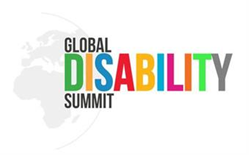
The Global Disability Summit
“The Global Disability Summit in London in 2018 succeeded in placing the issue of rights-based, disability-inclusive development on the agenda, and we have high ambitions for the Oslo Summit in 2022,” said Kari Hauge Riisøen, Norwegian Ministry of Foreign Affairs.
GENEVA (PRWEB)
September 23, 2021
The Global Disability Summit (GDS) Secretariat, along with its partners, has officially launched its new website to address disability inclusion in the world’s least developed countries.
The site will track a set of global commitments, originally made at the Global Disability Summit in 2018, to help bring about the critical inclusion needed for all persons with disabilities, who make up 15% of the world’s population.
“It is exciting to see so much progress from the 2018 Global Disability Summit and the momentum that it sparked across the world. I am looking forward to the Norway Summit and pleased that people with disabilities continue to be at the centre of preparations,” said Penny Innes, head of the Disability Inclusion team at FCDO in the UK.
National governments, multilateral agencies, donors, foundations, private sector and civil society organisations made a total of almost 1,000 individual commitments around four central themes – including ensuring dignity and respect for all, inclusive education, routes to economic empowerment, harnessing technology, and innovation.
Goal of GDS and this website
The Global Disability Summit has started a new wave in the disability rights movement. But GDS needs to show evidence that there is a move towards disability inclusive development and humanitarian action. Progress has begun. Despite the chaos caused by conflict, the economic repercussions of COVID-19 and the climate crisis, many of the commitments made at the first GDS in 2018 have reached their implementation phase.
At the 2022 Summit, the GDS Secretariat is hoping to see even more commitments than in 2018. Many are expected to emerge from the national and regional consultations with organizations of persons with disabilities (OPDs) that will inform the next Summit’s themes, priorities and preparations. In total, 20 workshops are planned across all regions of the world.
“The first GDS was a pivotal moment for disability-inclusive development showcasing concrete change for persons with disabilities,” said Vladimir Cuk, the Executive Director of the International Disability Alliance, and one of the co-hosts for GDS. “Close consultation with active involvement of persons with disabilities and their representative organizations is critical to addressing their situation on the ground and seeing how change can happen.”
The numerous examples and case studies to come out of the GDS process show the breadth of work and can now be seen on the website. Those examples include the adoption of the OECD-DAC disability marker by national development agencies such as Australia’s DFAT, Sweden’s SIDA and Canada’s GAC. UNICEF’s commitments have led to success in implementing programmes that are inclusive of children with disabilities in 53 countries, far surpassing its original target of 35 countries, among many others.
Importance of showing incremental change
Structural bias in day-to-day life often leads to the seeds of discriminatory thought. Celebrating the progress towards disability inclusiveness will allow everyone to see a better world where persons with disabilities are meaningfully included in all areas of life.
By following all past and future commitments, and supporting stakeholders to achieve the promises they have made, the GDS Secretariat provides substantive inputs and coordination to world changing discussions.
“Though the commitments themselves are really great – the evidence of how the work being done locally is being used by policymakers and practitioners, countrywide or globally, gives us a picture of the important linkages being made worldwide,” said José Viera, Senior Manager of the GDS Secretariat. “This will allow us to know how we are advancing disability rights in development.”
Though the first Summit, which was the largest event of its kind, brought in the biggest players in disability and development, a number of new stakeholders, including many from the private sector and large foundations, will be joining the events in 2022.
“The Global Disability Summit in London in 2018 succeeded in placing the issue of rights-based, disability-inclusive development on the agenda, and we have high ambitions for the Oslo Summit in 2022. We wish to build on the progress made after the first Global Disability Summit. We will seek new commitments, improved and more concrete action, to accelerate inclusive development, through access, engagement and equality,” said Kari Hauge Riisøen, Norwegian Ministry of Foreign Affairs.
“To make this happen we want close collaboration with states, multilateral organizations, civil society organizations, and a wide range of other partners. We look forward to collaborating closely on raising the bar and inspiring new ambitious commitments in the time leading up to the GDS.”
It also allows OPDs to be the main stakeholder in the preparation of the Summits and the mechanisms that feed into them. The new website serves as a platform for OPDs to consider the implementation of the commitments and gives them the responsibility to follow the commitments made by governments, UN agencies, and others.
Visit the website at http://www.globaldisabilityalliance.org and follow us on Twitter @GDS_Disability to get the most up-to-date information.
About the Global Disability Summit
The Global Disability Summit Secretariat was established to monitor the implementation of the commitments made at the first Global Disability Summit and the commitments that will be made in the future. It works to provide substantive inputs and coordination of the organization of the Global Disability Summits.
The Secretariat has established an accountability mechanism to follow the implementation of commitments, supporting stakeholders to achieve the promises they made.

